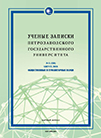ИСТОРИЯ В ФОРМИРОВАНИИ РЕГИОНАЛЬНОЙ ИДЕНТИЧНОСТИ
ЖИТЕЛЕЙ г. ВЫБОРГА В СОВЕТСКИЙ И ПОСТСОВЕТСКИЙ ПЕРИОДЫ
REGIONAL IDENTITY DEVELOPMENT OF VYBORG POPULATION
IN THE SOVIET AND POST-SOVIET PERIODS
Author(s): Yuri Gennadievich ShikalovSubject(s): History, Social Sciences, Geography, Regional studies, Information Architecture
Published by: Петрозаводский государственный университет
Keywords: Vyborg; regional identity; image of the region; town’s brand
Summary/Abstract: This article explores the problem of developing the concept of regional identity in Vyborg’s citizens from the late 1940s to the early 2000s. Since these processes are closely tied to the image or brand of the town, substantial emphasis is placed on the development of the town’s successive images and historical circumstances of their replacement. Three dominant images were revealed by the study. The first one was shaped right after the World War II and can be described by the formula “an ancient Russian town”. The second image was offered in the 1970s–1980s in order to make Vyborg an attractive destination for tourists from Finland. It was branded as “a home city for strangers”. The last image of Vyborg as a romantic and deeply medieval in spirit town is aimed at the enhancement of national tourism. The image was created in the early post-Soviet period and has been maintained until now.
Journal: Ученые записки Петрозаводского государственного университета. Общественные и гуманитарные науки
- Issue Year: 2016
- Issue No: 5 (158)
- Page Range: 13-20
- Page Count: 8
- Language: Russian

